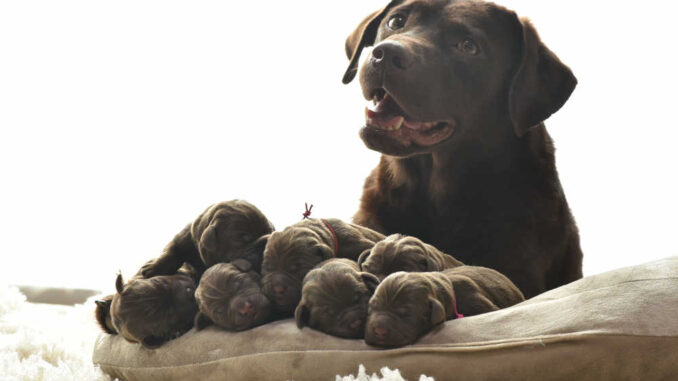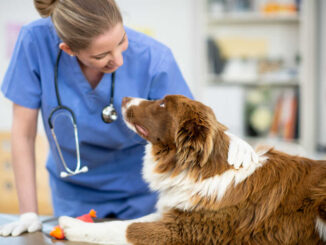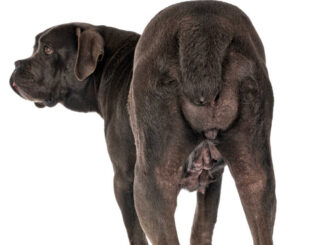
This article was updated on August 26th, 2023
When your dog is giving birth, a range of emotions may arise – excitement, nervousness, and even a little trepidation. To identify potential issues early and alleviate your concerns, it’s essential to learn about post-birth care. For example, it’s important to know what amount of bleeding is normal after a dog gives birth and when a dog bleeding after birth could be a problem.
Expect to See Some Bloody Discharge After Birth
After all, whelping can be a pretty traumatic experience and a female dog’s body goes through a lot (view our pictures of dog pregnancy week by week). Releasing some bloody discharge is how her body gets rid of all of the extra blood, fluids and debris that it accumulated over the last two months of pregnancy.
However, not all bleeding after giving birth in dogs is normal. So, let’s look into the kind of bleeding that you want to see.
Normal Bleeding Looks Dark Red or Greenish in The First 3-5 Days
The bloody discharge that you see after a dog gives birth should be a mix of old blood, fluids and other tissues that the body is getting rid of. It should contain very little fresh blood. So, expect it to look dark red or even a little greenish in color. You may recognize the green color if you were around for the birth as the pigment that surrounds each puppy. A greenish tinge to your dog’s discharge is normal for a few days following birth. The discharge may have some clot-looking material for the first few days as well.
Your pup should act normal, with a healthy appetite, good sleep routine, and pay proper attention to her pups.
Expect to See Some Bloody Discharge for 5-7 Days (And Up to Several Months)
“There will be a lot of variation between each female as to how long bleeding after birth lasts. For most dogs, expect to see some bloody discharge for at least 5-7 days to ensure proper cleaning of the reproductive tract. Some dogs may have discharge for a few weeks, and some will even have normal discharge for a few months.”
After 3-5 days, the amount of discharge should decrease and become lighter in color. The final stages of discharge will be thinner or watery, light pink or whitish, and very little in amount.
The bloody discharge should decrease in volume and become lighter colored with time. Again, even dogs that have normal discharge for months following whelping should act normally, be active, have a good appetite and care for their pups.
Keep Everything Clean & Do Frequent Spot Washes
Since some bleeding after birth in dogs is likely, it’s important to know how to monitor and care for your new mother.
1. Keep everything clean: First thing’s first, you’ll want to try to keep them as clean as possible. Change the bedding frequently or use puppy pads that you replace often. For longer-haired females, a sanitary trim may work well where the long hair is trimmed from around the genital area to prevent blood from sticking to it.
2. Do frequent spot washes: You can also do frequent spot washes with a damp towel or grooming wipes to remove any stuck on bloody discharge. Don’t use doggy diapers or other products that could block the mammary glands.
“Prepare for your dog to be messy for at least a week and possibly more as she flushes her reproductive system. Be sure to call the vet any time you have any questions about your dog’s post-partem bleeding, health, or the health of the puppies.”
What is Abnormal Bleeding After Birth in Dogs?
Even though bleeding following whelping can be alarming, dark red discharge that decreases in volume for up a few months is quite normal. What’s not normal is when that bleeding is different colored, has an odor, or becomes excessive. Seek veterinary care if your dog shows any of the following:
Bright Red Blood
Dogs should bleed very little during a normal whelping and shouldn’t show any fresh blood after that. Normal bloody discharge is dark red because it’s old blood that your dog’s body is getting rid of. Seeing bright red blood, such as what you would see from a cut, should be looked at by a vet immediately. This usually indicates that there is damage somewhere in the reproductive tract that could be fatal if not fixed.
Yellow or Green Discharge with an Odor
Yellowish, greenish, or pus-looking discharge all present a problem for your pup. So does bloody discharge with an odor. These may be signs that your dog has an infection in her reproductive tract that could make her very sick if it’s not addressed.
Excessive Bleeding
There’s no set amount of bloody discharge that your dog will have after giving birth, so there’s no point in trying to keep track. Instead, look for changes, such as a lot of discharge following several days without any or discharge that lasts longer than eight weeks. Both of these should warrant a veterinary visit and could mean that something is off.
Dog Acting Off
Bleeding after birth that lasts and lasts can be completely normal, so can excessive amounts of bloody discharge, as long as your dog is acting ok. If instead your dog starts to behave differently, such as not eating, not wanting to move, or not taking care of her puppies, see your veterinarian.
How Can Your Vet Help With Bleeding After Birth?
The treatment for abnormal bleeding after birth in dogs is going to depend on the cause. Dogs that have a tear or other damage to the reproductive tract may require surgery. So, if you see bright red blood or if your dog is acting lethargic with pale gums, see your vet immediately. Some of these surgeries may require removing the uterus. Since this is an emergency situation, higher fees may apply. Look to pay $300-$700 or more.
Infections after giving birth are often due to a retained fetal membrane, or the tissue that houses the puppy within the uterus. These are normally passed out of the body during whelping, but sometimes fail to clear. Eventually, they can lead to an infection as the tissue decomposes. These infections can make a pup awfully sick and may require nursing care, like fluids, along with antibiotics, and oxytocin to help flush the tissue.
Post-partum infections can occur for other reasons too and will often require antibiotics to clear up. Depending on how sick your dog is, you may need supportive care and even hospitalization. Expect to pay anywhere from $50-$300+.
In some cases, abnormal bleeding after birth can be due to an undiagnosed bleeding disorder, such as von Willebrand Disease. Dogs may require a blood transfusion in order to get the bleeding and anemia under control. This cost $100-$500 and more with hospitalization.
What Happens to Your Dog’s Body After Birth?
The pregnancy and whelping process takes a lot out of a mother and really puts her body through a lot of changes. Besides a little bleeding after birth, you’ll also going to notice other physical and behavioral changes.
- Tiredness: Expect lots of panting in the hours following whelping. The new mama will be exhausted but not able to sleep much, so prepare her best by giving her a quiet, calm place to rest.
- Aggression: Some females will become very possessive of her pups and can even become aggressive towards people or other animals that try to come near. Allow her her space so that she feels comfortable, but still keep a close eye on her from a distance.
- Decreased appetite: For those first few hours or even into the next few days, your dog may not feel much like eating. She instead will focus her energy on caring for her pups and getting much needed shuteye.
- Enlarged mammary glands: Just before whelping and in the days after, your dog’s mammary glands are going to increase in size immensely as they fill with milk. Monitor them for signs of soreness, hotness, or redness as these can be signs of mastitis.
- Depression: The rapid change of hormones that come with whelping can leave your pup a little depressed. If she stops showing interest in her pups, food, or activity, see your veterinarian.
Related posts about dog pregnancies:
- Best home dog pregnancy test kits
- How to tell if your dog is pregnant
- Pictures of dog pregnancy week by week
Disclaimer: This website's content is not a substitute for veterinary care. Always consult with your veterinarian for healthcare decisions. Read More.






Be the first to comment